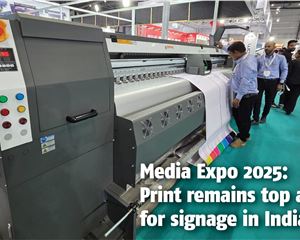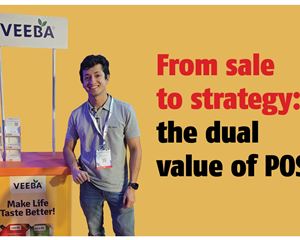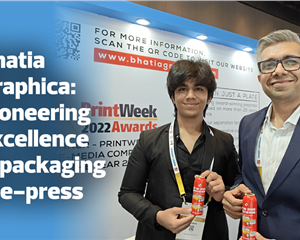Bobst demystifies hot foil stamping
Jacques Reymond, head of product marketing business unit sheetfed at Bobst explains how hot foil stamping helps packaging to shine
14 Sep 2019 | By WhatPackaging? Team
According to Reymond, differentiation is what every brand owner wants for their product, but in increasingly crowded markets, it is becoming harder to achieve.
He says, “Brand owners know that packaging is the key differentiator on the shelf, and special finishing techniques – such hot foil stamping and thermal embossing – can elevate their product compared to others, and provide consumers with a visual shortcut to the quality of what’s inside.”
What is hot foil stamping?
Hot foil stamping is the process of using heat and pressure to apply metallic foil or holograms to materials such as light papers, carton board, laminated board, plastics and corrugated board.
“Hot foil stamping helps to reinforce the value to the product and is often associated with premium products. Ultimately, the box is a marketing instrument, and by using hot foil stamping, you can convey the quality of what it inside,” says Reymond.
The term can encompass simple flat foil stamping, deep embossing or embossing combined with foil stamping, hologram and holographic foil application and foil stamping combined with micro and structural embossing. Traditionally, gold or silver are the most common colors used for foiling, but a wide range of coloured foils are available.
Application across industries
Hot foil stamping is used across a wide range of industry sectors, but most notably in food and drink (particularly confectionary such as premium chocolate, wine and liquor bottles, and other premium foods), cosmetics, electronics, banknotes, business cards, greeting cards and art work.
According to a study by the Foil and Specialty Effects Association (FSEA), hot foil stamping and other similar enhancements on product packaging can help attract consumer attention faster and keep attention longer than ordinary packaging.

In another study of disposable single-serve coffee packaging, the packaging with gold foil attracted the study participants’ attention 2.5 times faster than the control packaging. Hot foil stamping is also used for its anti-counterfeiting properties, particularly in pharmaceuticals, and in technology such as smart phones.
The stamp of sustainability
Many assume that packaging with foil is not recyclable and therefore not sustainable, but a study by the FSEA on the recyclability and re-pulpability of foil-decorated stock and board validated the recyclability of paper products decorated by the traditional hot stamp foil processes.
In addition, the study found that neither hot nor cold foil-decorated products would give rise to problems that may render the decorated paper products unsuitable for recycling.
How is hot foil stamping evolving?
Hot foil stamping has been around in one form or another for well over 100 years. The process itself has not changed dramatically in that time, but the technology is evolving and enabling better efficiency for manufacturers.
A hot foil stamper may be an offline, stand-alone machine, or may be in line with a printing press and/or other units. While mainly sheetfed, some high-speed hot foil stampers are webfed. Whether sheet or webfed, handling systems are needed to position the substrate and foil between the plate or cylinder that holds the dies and that supplying the counter pressure.
Bobst’s range of hot foiling machines
“The hot foil stamping machines have seen some remarkable advances in recent years. For example, normally, hot foil stamping requires several passes through the machine – the printing, then the enhancement, then the cutting. That’s a lot of movement on the sheet registration. But Bobst integrated a Power Register 2 in MASTERFOIL 106 PR, which delivers perfect foil-to-print register that overcame that. We are always looking to evolve.”
The Power Register 2 has additional features like lower beam cam movement, which allows for longer impressions and higher foiling quality, or a foil unwind system that makes changing foils as easy as pressing a button.

“With over fifty years’ experience in the hot foil stamping market, and several thousand installations worldwide, we are a pioneer in the area,” says Reymond.
He adds, “We are well known for providing equipment that is long lasting, and made for high productivity, precision and quality. And we never get complacent; we are always moving forward, always looking to the future to find new ways to improve productivity for our customers.”
According to Bobst, it’s EXPERTFOIL 142 it’s the only size VI die-cutter hot foil stamping machine on the market. Until it’s arrival, only ‘bolt-on’ foiling solutions were available to finishers working in the size VI format. It is a machine that gives customers a bigger margin to make a margin. Getting extra products onto a sheet can dramatically change the profitability of the process, especially when margins are tight,” says Reymond.
Bobst has developed an entire range of hot foil stamping solutions that cover the complete range of production needs, from straightforward block foiling, through hologram application with accuracy, to the creation of highly complex foil effects.
Conclusion
While hot foil stamping isn’t the only form of differentiation for packaging – cold foil, varnishes and metal inks are just three examples of other great visual embellishments – it is a steadily growing sector that is here to stay. Simply put, the effect will always appeal on packaging and provide a visual shortcut to the quality of the product inside.












 See All
See All